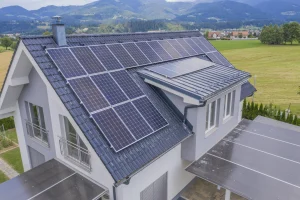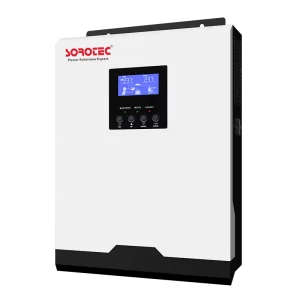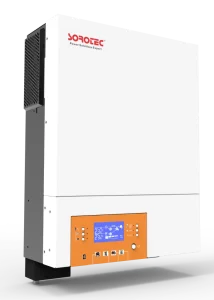Learn how to calculate the energy production of commercial solar panels in this insightful guide.Whether you’re powering a business or industrial facility, this article provides practical steps to estimate output and make informed decisions. Visit Sorotec for innovative solar solutions and start harnessing clean energy today!
Solar panels play a vital role in capturing clean energy. They help businesses tap into renewable power. Knowing the different types is key for companies planning installations. Each type brings unique advantages suited to specific needs.
Monocrystalline Solar Panels
Single-crystal panels stand out for their strong performance and high efficiency. They’re made from one crystal structure. This design lets them convert sunlight into power effectively. Their sleek, dark look appeals to modern setups. These panels blend style with function. Yet, their advanced production process makes them costlier than other options.
Single-crystal panels offer top efficiency. They suit businesses seeking powerful, space-saving solutions.
Polycrystalline Solar Panels
Multi-crystal panels provide a budget-friendly choice. They’re slightly less efficient than single-crystal models. These panels come from multiple silicon pieces melted together. They have a blue, speckled appearance. While not as efficient, they deliver solid energy output over large spaces. This makes them ideal for businesses with big rooftops.
Multi-crystal panels balance cost and performance. They’re a smart pick for expansive projects.
Thin Film Solar Panels
Thin-layer panels shine for their flexibility and light weight. They’re perfect for unique installations where rigid panels don’t fit. These panels have lower efficiency compared to crystal-based options. But their adaptability suits aesthetic or temporary setups. They’re ideal for creative or non-traditional surfaces.
Thin-layer panels offer versatility. They cater to businesses needing lightweight, flexible energy solutions.
Sorotec, a trusted energy expert, guides businesses in choosing the right panel type. Their tailored solutions ensure maximum efficiency. Panel types set the stage. Now, let’s explore how much power industrial systems generate.
How Much Power Does An Industrial Solar Panel Generate?
The energy output of industrial solar panels depends on several factors. These affect their efficiency and power production.
System Size
System size is a major driver of energy output. Bigger systems produce more electricity. They suit large commercial operations. For businesses with high energy needs, a properly sized system reduces reliance on grid power. This ensures steady supply.
Panel Count
More panels don’t always mean more power. Efficiency matters too. High-efficiency panels generate more electricity with fewer units. This saves space and budget. Fewer panels can still meet energy goals if they’re highly efficient.
Positioning and Orientation
Panel placement impacts sunlight capture. Ideally, panels face south at a 35-degree angle. This maximizes solar exposure. Other angles still produce power, but less efficiently. Proper orientation boosts output significantly.
Daylight Hours
Sunlight hours directly affect energy production. Places with long sunny days generate more power. Seasonal changes matter too. Summer brings longer days and higher output. Winter reduces production due to shorter daylight.
| Factor | Impact on Energy Production |
| System Size | Larger systems = More energy |
| Panel Efficiency | Higher efficiency = More output |
| Positioning | Optimal angles = Maximum radiation |
| Daylight Hours | Longer days = Increased generation |
Panel Ratings
Each panel’s rating, measured in watts, shows its power potential. Ratings range from 250 to 520 watts. High-rated panels deliver better performance. They align with commercial energy needs. Choosing strong panels ensures reliable output.
Maintenance
Regular upkeep keeps panels performing well. Dust or debris blocks sunlight. This cuts efficiency. Professional cleaning maintains output. Sorotec offers maintenance services to keep systems at peak performance. Check their solutions here.
Power output leads to questions about panel efficiency.
What Is Solar Panel Efficiency?
Efficiency is a key measure for solar panels. It shows how well a panel turns sunlight into usable power. Higher efficiency means more energy from less space.
Efficiency is critical. Let’s see how commercial panels are evaluated.
How Is the Efficiency of Commercial Solar Panels Measured?
Panel efficiency is calculated simply. Divide the panel’s power (in kW) by its area (length x width). Multiply by 100. This gives the percentage of sunlight turned into electricity under standard conditions.
Commercial panels typically hit 20% efficiency. Advanced designs, like enhanced cell technology, boost this by about 5%. This lets businesses use smaller systems without losing output. Future research aims for up to 50% efficiency.
| Efficiency Level | Description |
| Standard | Around 20% |
| Advanced | Up to 25% |
| Future Potential | Research targets up to 50% |
Location and weather affect real-world performance. Sorotec delivers innovative, high-efficiency solutions. Their products meet diverse commercial needs. Visit their homepage here for more.
Efficiency measurements pave the way for maximizing performance.
Maximizing the Efficiency of Solar Panels
Solar panels transform how businesses access clean energy. Boosting their efficiency ensures better output and stronger returns.
Factors Influencing Solar Panel Efficiency
Several factors shape panel performance. Each plays a role in energy production.
System Size and Panel Count
System size drives energy output. Larger systems produce more power. They’re ideal for commercial needs. But panel efficiency matters too. High-efficiency panels deliver more energy with fewer units. This optimizes space and cost.
Positioning and Orientation
Correct placement maximizes sunlight. Panels should face south at a 35-degree angle. This captures the most solar rays. Other angles work but reduce efficiency. Good orientation is key to performance.
Daylight Hours and Weather Conditions
Sunlight hours impact output. Long, sunny days boost production. Summer months yield more due to extended daylight. Weather like clouds lowers output but doesn’t stop it.
| Factor | Impact on Energy Production |
| System Size | Larger systems = More energy |
| Panel Efficiency | Higher efficiency = More output |
| Positioning | Optimal angles = Maximum radiation |
| Daylight Hours | Longer days = Increased generation |
Maintenance for Optimal Performance
Regular cleaning prevents efficiency loss. Dust or debris blocks sunlight. Professional services keep panels in top shape. Efficiency factors lead to comparisons between commercial and home panels.
Are Commercial Solar Panels More Efficient Than Residential Solar Panels?
Commercial panels are built for large-scale energy needs. They’re often more efficient than home panels.
Differences Between Commercial and Residential Panels
Commercial panels are larger. This boosts their efficiency slightly, by about 2%. More solar cells mean better sunlight conversion. Advanced technologies, like enhanced cell designs, increase output by 5%. Smaller systems can still meet high demands.
Types of Solar Panels Used in Commercial Settings
- Single-Crystal Panels: High efficiency, sleek design.
- Multi-Crystal Panels: Cost-effective for big installations.
- Thin-Layer Panels: Flexible for unique or aesthetic setups.
Energy Production Capabilities
Commercial 72-cell panels generate around 400 watts. 96-cell panels hit up to 500 watts. Panel type, placement, and location shape total output. Sorotec guides businesses to the right system.
Efficiency differences raise questions about commercial solar’s value.
Is Investing in Commercial Solar Worth It?
Commercial solar brings big benefits. It’s more than just cost savings.
Financial Advantages
- Lower Costs: Solar cuts electricity bills. This frees up cash for business growth.
- Tax Breaks: Federal credits (30% ITC) reduce upfront costs.
- Higher Property Value: Solar-equipped buildings attract better valuations.
Sustainability Benefits
- Energy Freedom: On-site power shields against utility price spikes.
- Green Impact: Solar lowers carbon emissions. It appeals to eco-conscious customers.
- Brand Boost: Sustainable practices enhance reputation.
Challenges and Payback Period
Upfront costs can be high. But incentives make solar affordable. A $500,000 system with 30% ITC and $2,000 monthly savings pays off in about 9.5 years. After that, enjoy free energy for 25-30 years.
Sorotec: Your Trusted Power Solution Expert
Sorotec leads in clean energy solutions. They tailor systems to business needs. With years of expertise, Sorotec delivers high-efficiency solar setups. Their solutions cut costs and boost sustainability. Expert support leads to practical questions about solar performance.
FAQs:
Q1: How does weather impact solar panel performance?
A: Weather affects solar panel output. Sunlight drives energy production. Clouds reduce sunlight, lowering generation. Panels still work on overcast days, just less efficiently.
Cooler temperatures boost efficiency. High heat can cut performance slightly. Summer’s long days increase output. Winter’s shorter days reduce it.
Q2: Can commercial solar panels work during cloudy days?
A: Yes, panels function on cloudy days. Output is lower than on sunny days. Sunlight still reaches panels through clouds. They keep generating power.
Key factors include:
- Panel Efficiency: High-efficiency panels capture more light.
- Panel Type: Single-crystal panels excel in low light.
- Advanced Tech: Enhanced designs improve light absorption.
Battery storage helps. It saves extra energy from sunny days for cloudy ones. Sorotec offers storage solutions for steady power.
Q3: What is the lifespan of a commercial solar panel system?
A: Commercial systems last 25-30 years. Some extend longer. High-efficiency panels often carry 25-year warranties. They guarantee solid output over time.
Efficiency drops gradually, about 85% by year 25. Regular cleaning and inspections maintain performance.









